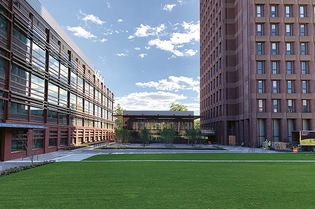 loading
loading
Light & VerityMeetings of the mindsA new laboratory building helps remake Science Hill.  Mark Zurolo ’01MFAView full imageOne of the biggest pieces in a major reshuffling of Science Hill fell into place this fall when the university dedicated a new $283 million structure on the former site of Gibbs Laboratory. The seven-story Yale Science Building houses 550 employees, 45 biology and physics laboratories, a large lecture hall, a rooftop greenhouse, and an imaging center. (If the building’s name strikes you as unusually generic, there’s a possibility that it won’t be permanent; the development office lists it as a $100 million naming opportunity.) The new building is a win, most notably, for Yale’s department of Molecular, Cellular & Developmental Biology, which now has new state-of the-art lab space to replace inadequate quarters in the high-rise Kline Biology Tower. “The department was literally stratified by floor, and there wasn’t a sense of community,” says Dean of Science Jeffrey Brock ’92 about Kline. “Because labs take up a significant amount of space, you would only have a handful of principal investigators on a floor.” The YSB was carefully designed to encourage interaction among scientists who otherwise might never interact. It has conference rooms, welcoming common spaces, and long, wide hallways lined with whiteboards. “If you’re having a discussion, it’s nice to be able to turn right there and start writing on the wall,” says Brock. And conversations across disciplines can lead to new and remarkable ideas. In addition to the biology laboratories, the YSB has something the physics department had long sought: four new laboratories, built into the Science Hill bedrock to prevent vibration interference in sensitive optical experiments. And all of the laboratories are designed for minimum obsolescence. It’s all about adaptability, says Anna Marie Pyle, Sterling Professor of Molecular, Cellular, & Developmental Biology, who chaired the building committee. “The labs can be completely dismantled and transformed to accommodate new kinds of science we can’t imagine today,” she explained at the building’s grand opening. Now that the YSB is open, Kline Biology Tower will be emptied out and renovated as the new home of the mathematics, astronomy, and statistics & data science departments, as well as parts of the physics department. (Faculty in these disciplines don’t require large lab spaces, so there can be more faculty on each floor.) When it reopens in 2022, Kline Tower will also feature a classroom floor and a penthouse event space with views of the campus and beyond. Bringing all these departments—now scattered in small buildings and houses on Hillhouse Avenue—together on Science Hill will further Yale’s goal of interdisciplinary interaction. One key to communing, says Brock, will be the new glass pavilion that connects Kline Tower and the YSB. In addition to views of the surrounding landscape, it has common space and a café. And it is open to everyone. “The pavilion space is going to be an important place for extemporaneous gathering and conversation,” Brock says, a place for “convening with other faculty from around the campus.” What’s more, the new buildings are part of an effort to make Science Hill more accessible to students, particularly to nonscientists who have rarely had reason to make the hike from the center of campus. The location of two new residential colleges nearby was part of the strategy. So is the inclusion of the Marsh Lecture Hall in the YSB. With nearly 500 seats, Marsh is one of the largest classroom venues on campus. By scheduling large courses in subjects like economics or psychology in Marsh, the college is pulling undergrads from outside the hard sciences up the hill. And who knows what might happen when they start chatting with a physicist in line for coffee?
The comment period has expired.
|
|